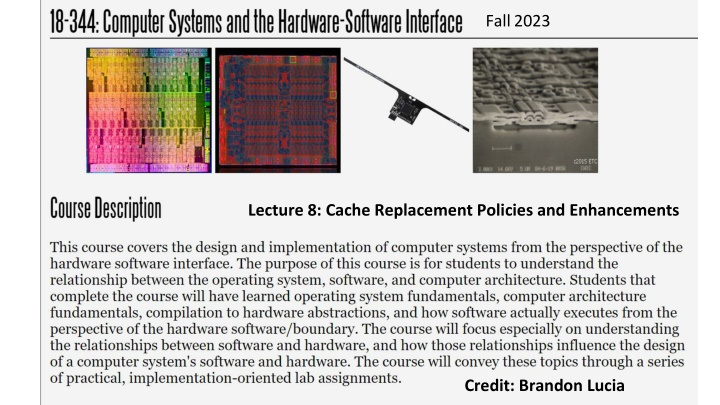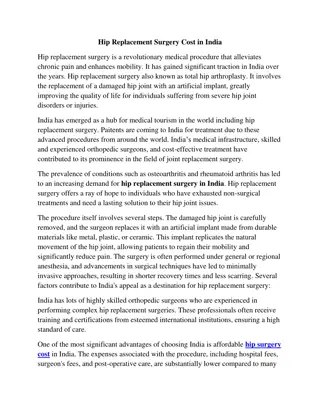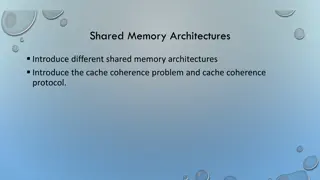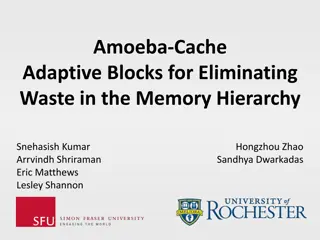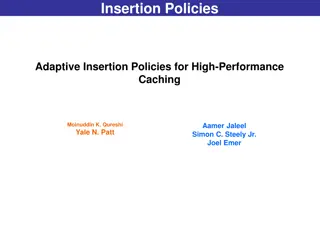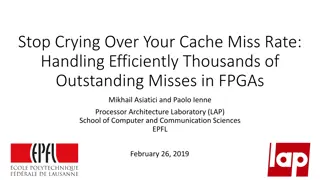Cache Replacement Policies and Enhancements in Fall 2023 Lecture 8 by Brandon Lucia
The Fall 2023 Lecture 8 by Brandon Lucia delves into cache replacement policies and enhancements for efficient memory management. The session covers the intricacies of replacement policies such as Round Robin, discussing evictions and block prioritization within cache sets. Visual aids and examples are used to illustrate the concepts, offering a comprehensive understanding of cache operations and eviction strategies.
Download Presentation

Please find below an Image/Link to download the presentation.
The content on the website is provided AS IS for your information and personal use only. It may not be sold, licensed, or shared on other websites without obtaining consent from the author.If you encounter any issues during the download, it is possible that the publisher has removed the file from their server.
You are allowed to download the files provided on this website for personal or commercial use, subject to the condition that they are used lawfully. All files are the property of their respective owners.
The content on the website is provided AS IS for your information and personal use only. It may not be sold, licensed, or shared on other websites without obtaining consent from the author.
E N D
Presentation Transcript
Fall2023 Lecture 8: Cache Replacement Policies and Enhancements Credit: Brandon Lucia
Replacement Policies lb x6 0x7fff0053 Byte M 0011 Way 2 Way 0 Way 1 Way 3 fset 9 L3$ Set 0 Line . . . Which block in the set should we evict to make space for the new block? @ 0x7fff0000 32 Byte Block Set 1 ache ontroller Set 2 . . . 0,0,0x7fff00, 1,1,0x001e00, 1,0,0x7fff10, 1,0,0x000000, Byte 2 Set 3 Byte 1 Byte 0
Replacement Policies Round Robin lb x6 0x7fff0053 Byte M 0011 Way 2 Way 0 Way 1 Way 3 fset 9 L3$ Set 0 Line . . . @ 0x7fff0000 32 Byte Block Set 1 Evict Next ache ontroller Set 2 . . . 0,0,0x7fff00, 1,1,0x001e00, 1,0,0x7fff10, 1,0,0x000000, Byte 2 Set 3 Byte 1 Byte 0
Replacement Policies Round Robin lb x6 0x7fff0053 Byte M 0011 Way 2 Way 0 Way 1 Way 3 fset 9 L3$ Set 0 Line . . . @ 0x7fff0000 32 Byte Block Set 1 Evict Next ache ontroller Set 2 . . . 0,0,0x7fff00, 1,1,0x001e00, 1,0,0x7fff10, 1,0,0x000000, Byte 2 Set 3 Byte 1 Byte 0
Replacement Policies Round Robin lb x6 0x7fff0053 Byte M 0011 Way 2 Way 0 Way 1 Way 3 fset 9 L3$ Set 0 Line . . . @ 0x7fff0000 32 Byte Block Set 1 Evict Next ache ontroller Set 2 . . . 0,0,0x7fff00, 1,1,0x001e00, 1,0,0x7fff10, 1,0,0x000000, Byte 2 Set 3 Byte 1 Byte 0
Replacement Policies Round Robin lb x6 0x7fff0053 Byte M 0011 Way 2 Way 0 Way 1 Way 3 fset 9 L3$ Set 0 Line . . . @ 0x7fff0000 32 Byte Block Set 1 Evict Next ache ontroller Set 2 . . . 0,0,0x7fff00, 1,1,0x001e00, 1,0,0x7fff10, 1,0,0x000000, Byte 2 Set 3 Byte 1 Byte 0
Replacement Policies Round Robin lb x6 0x7fff0053 Byte M 0011 Way 2 Way 0 Way 1 Way 3 fset 9 L3$ Set 0 Line . . . @ 0x7fff0000 32 Byte Block Set 1 Evict N Ne ex xt t ache ontroller Set 2 . . . 0,0,0x7fff00, 1,1,0x001e00, 1,0,0x7fff10, 1,0,0x000000, Byte 2 Set 3 Byte 1 Byte 0
Replacement Policies Round-Robin Analysis lb x6 0xe lb x6 0xb Evict Next lb x6 0xc lb x6 0xd Set 0 d a b c lb x6 0xa Advantage: Simple to implement and understand Disadvantage: Hopefully the next to evict isn t going to be the next to be accessed
Replacement Policies Round-Robin Analysis lb x6 0xe lb x6 0xb Evict Next lb x6 0xc lb x6 0xd Set 0 d a e c lb x6 0xa Advantage: Simple to implement and understand Disadvantage: Hopefully the next to evict isn t going to be the next to be accessed
Replacement Policies Round-Robin Analysis lb x6 0xe lb x6 0xb Evict Next lb x6 0xc lb x6 0xd Set 0 d a e b lb x6 0xa Advantage: Simple to implement and understand Disadvantage: Hopefully the next to evict isn t going to be the next to be accessed
Replacement Policies Round-Robin Analysis lb x6 0xe lb x6 0xb Evict Next lb x6 0xc lb x6 0xd Set 0 c a e b lb x6 0xa Advantage: Simple to implement and understand Disadvantage: Hopefully the next to evict isn t going to be the next to be accessed
Replacement Policies Round-Robin Analysis lb x6 0xe lb x6 0xb Evict Next lb x6 0xc lb x6 0xd Set 0 c d e b lb x6 0xa Advantage: Simple to implement and understand Disadvantage: Hopefully the next to evict isn t going to be the next to be accessed
Replacement Policies Round-Robin Analysis lb x6 0xe lb x6 0xb Evict Next lb x6 0xc lb x6 0xd Set 0 c d a b lb x6 0xa Advantage: Simple to implement and understand Disadvantage: Hopefully the next to evict isn t going to be the next to be accessed
Minimum Number of Misses? lb x6 0xe lb x6 0xb lb x6 0xc lb x6 0xd Set 0 d a b c lb x6 0xa What is the best replacement strategy to minimize misses & why?
Minimum Number of Misses? lb x6 0xe lb x6 0xb Evict Next lb x6 0xc lb x6 0xd Set 0 d a b c lb x6 0xa
When are we going to re-use cached data? lb x6 0xe Miss lb x6 0xb Hit lb x6 0xc Hit Hit lb x6 0xd Set 0 d e b c Miss lb x6 0xa Replacement decisions must be informed by the next reuse of a block of data. Think: what is an optimal policy? How far in the future is something going to be used again?
When are we going to re-use cached data? lb x6 0xe Miss lb x6 0xb Hit lb x6 0xc Hit Hit lb x6 0xd Set 0 c d a b Miss lb x6 0xa What defines optimality for a cache replacement algorithm?
Beladys MIN Algorithm for Optimal Replacement lb x6 0xe Miss lb x6 0xb Hit lb x6 0xc Hit Hit lb x6 0xd Set 0 c d a b Miss lb x6 0xa B l dy L szl : What defines optimality for a cache replacement algorithm? Evict the cached element that will be used furthest in the future.
Beladys MIN Algorithm for Optimal Replacement lb x6 0xe lb x6 0xa lb x6 0xb lb x6 0xa lb x6 0xc lb x6 0xa lb x6 0xd lb x6 0xa lb x6 0xe lb x6 0xa lb x6 0xf lb x6 0xe Set 0 c d a b
Beladys MIN Algorithm for Optimal Replacement lb x6 0xe lb x6 0xa lb x6 0xb lb x6 0xa lb x6 0xc lb x6 0xa lb x6 0xd lb lb x6 lb x6 0xa lb x6 0xf lb x6 0xe Set 0 c d a b x6 0xa 0xe reuse distance: 6 reuse distance: 1 reuse distance: 2 reuse distance: 4
Beladys MIN Algorithm for Optimal Replacement lb x6 0xe lb x6 0xa lb x6 0xb lb x6 0xa lb x6 0xc lb x6 0xa lb x6 0xd lb lb x6 lb x6 0xa lb x6 0xf lb x6 0xe Evict Next Set 0 c d a b x6 0xa 0xe reuse distance: 6 reuse distance: 1 reuse distance: 2 reuse distance: 4
Beladys MIN Algorithm for Optimal Replacement lb x6 0xe lb x6 0xa lb x6 0xb lb x6 0xa lb x6 0xc lb x6 0xa lb x6 0xd lb lb x6 lb x6 0xa lb x6 0xb lb x6 0xa Set 0 c e a b x6 0xa 0xe reuse distance: 2 reuse distance: 1 reuse distance: 4 reuse distance:
Beladys MIN Algorithm for Optimal Replacement lb x6 0xe lb x6 0xa lb x6 0xb lb x6 0xa lb x6 0xc lb x6 0xa lb x6 0xd lb lb x6 lb x6 0xa lb x6 0xb lb x6 0xa Evict Next Set 0 c e a b x6 0xa 0xe reuse distance: 2 reuse distance: 1 reuse distance: 4 reuse distance:
Beladys MIN Algorithm for Optimal Replacement findBlockMIN(){ 0://init reuse distances 1:for each block in cache, b: 2: RD[b] = 0; RD_done[b] = false; 3://look forward in the execution trace 4:for each access, a, forward in execution trace: 5://increment reuse distance for each block not already seen 6: 7: 8: 9: RD_done[a.block] = true 10://MIN finds the block with maximum RD 11:return argmax(b,RD[b]) for each block in cache, b: if RD_done[b] == false: RD[b]++; MIN results in the MINimum number of replacements in a cache for an execution trace.
Beladys MIN Algorithm for Optimal Replacement findBlockMIN(){ 0://init reuse distances 1:for each block in cache, b: 2: RD[b] = 0; RD_done[b] = false; 3://look forward in the execution trace 4:for each access, a, forward in execution trace: 5://increment reuse distance for each block not already seen 6: 7: 8: 9: RD_done[a.block] = true 10://MIN finds the block with maximum RD 11:return argmax(b,RD[b]) for each block in cache, b: if RD_done[b] == false: RD[b]++; See any limitations of the MIN algorithm for cache replacement?
Beladys MIN Algorithm for Optimal Replacement findBlockMIN(){ 0://init reuse distances 1:for each block in cache, b: 2: RD[b] = 0; RD_done[b] = false; 3://look forward in the execution trace 4:for each access, a, forward in execution trace: 5://increment reuse distance for each block not already seen 6: 7: 8: 9: RD_done[a.block] = true 10://MIN finds the block with maximum RD 11:return argmax(b,RD[b]) for each block in cache, b: if RD_done[b] == false: RD[b]++; Need omniscient future knowledge of the execution trace of your program! MIN is optimal, but not practically implementable
Practical Replacement Algorithms lb x6 0xe lb x6 0xa lb x6 0xb lb x6 0xa lb x6 0xc lb x6 0xa lb x6 0xd lb x6 0xa lb x6 0xe lb x6 0xa lb x6 0xb lb x6 0xe General idea: Assume the near future is similar to the recent past knowable Set 0 c e a b guessable If a block was used recently, it will be used again soon
Least-Recently Used (LRU) Replacement lb x6 0xe lb x6 0xa lb x6 0xb lb x6 0xa lb x6 0xc lb x6 0xa lb x6 0xd lb x6 0xa lb x6 0xe lb x6 0xa lb x6 0xb lb x6 0xe Evict the block that was used the furthest in the execution s past knowable Set 0 c e a b guessable If a block was not used recently, it will not be used again soon
Least-Recently Used (LRU) Replacement Evict the block that was used the furthest in the execution s past lb x6 0xe lb x6 0xa lb x6 0xb lb x6 0xa lb x6 0xc lb x6 0xa lb x6 0xd lb x6 0xa lb x6 0xe lb x6 0xa lb x6 0xb lb x6 0xe knowable Evict Next Set 0 c e a b guessable last use: -6 last use: -1 last use: -4 last use: -2 LRU s Gamble: Haven t used block 0xe for longest, probably won t use it again any time soon, either If a block was not used recently, it will not be used again soon
Least-Recently Used (LRU) Replacement Evict the block that was used the furthest in the execution s past lb x6 0xe lb x6 0xa lb x6 0xb lb x6 0xa lb x6 0xc lb x6 0xa lb x6 0xd lb x6 0xa lb x6 0xe lb x6 0xa lb x6 0xb lb x6 0xe knowable MIN Evicts LRU Evicts Set 0 c e a b guessable last use: -6 last use: -1 last use: -4 last use: -2 Caveat: LRU is wrong if past does not predict future Caveat to caveat: past usually predicts future well If a block was not used recently, it will not be used again soon
(Nave) LRU Algorithm & Implementability accessCacheLRU(access a){ for each block in cache, b: if b != a.block: LRU_Age[b]++ LRU_Age[b] = 0 } findBlockLRU(){ return argmax(b,LRU_Age) } Implementability and limitations of LRU?
(Nave) LRU Algorithm & Implementability accessCacheLRU(access a){ for each block in cache, b: if b != a.block: LRU_Age[b]++ LRU_Age[b] = 0 } findBlockLRU(){ return argmax(b,LRU_Age) } Implementability! Does not require unknowable information about future of execution Limitation! Requires accessing metadata for every block on each access to any block. Time & energy cost to update ages. Area & power cost to store age values. Does not scale beyond about 4 way set associativity.
Bit-Pseudo-Least-Recently Used (Bit-PLRU) Evict a block that was definitely not most recently used lb x6 0xe lb x6 0xa lb x6 0xb lb x6 0xa lb x6 0xc lb x6 0xa lb x6 0xd lb x6 0xa lb x6 0xe lb x6 0xa lb x6 0xb lb x6 0xe knowable Set 0 c e a b guessable MRU: 0 MRU: 1 MRU: 0 MRU: 0 Set MRU bit when block is used (most recently), clear all MRU bits when all MRU bits are set, evict the left-most block with unset MRU bit
Bit-Pseudo-Least-Recently Used (Bit-PLRU) Evict a block that was definitely not most recently used lb x6 0xe lb x6 0xa lb x6 0xb lb x6 0xa lb x6 0xc lb x6 0xa lb x6 0xd lb x6 0xa lb x6 0xe lb x6 0xa lb x6 0xb lb x6 0xe knowable Bit-PLRU Evicts Set 0 c e a b guessable MRU: 0 MRU: 1 MRU: 0 MRU: 0 Set MRU bit when block is used (most recently), clear all MRU bits when all MRU bits are set, evict the left-most block with unset MRU bit
Bit-Pseudo-Least-Recently Used (Bit-PLRU) Evict a block that was definitely not most recently used lb x6 0xe lb x6 0xa lb x6 0xb lb x6 0xa lb x6 0xc lb x6 0xa lb x6 0xd lb x6 0xa lb x6 0xe lb x6 0xa lb x6 0xb lb x6 0xe LRU Evicts knowable MIN Evicts Bit-PLRU Evicts Set 0 c e a b guessable MRU: 0 MRU: 1 MRU: 0 MRU: 0 Bit-PLRU is a decent approximation of LRU
Bit-PLRU Algorithm & Implementability accessCachePLRU(access a){ MRU_Bit[a.block] = 1 if ++MRU_BitSum == setSize: for each block in cache, b: MRU_Bit[b] = 0 MRU_BitSum = 0 } findBlockLRU(){ for i in 0..setSize: if !MRU_Bit[i]: return block(i); } Implementability and limitations of Bit-PLRU?
Bit-PLRU Algorithm & Implementability accessCachePLRU(access a){ MRU_Bit[a.block] = 1 if ++MRU_BitSum == setSize: for each block in cache, b: MRU_Bit[b] = 0 MRU_BitSum = 0 } findBlockLRU(){ for i in 0..setSize: if !MRU_Bit[i]: return block(i); } Implementability! No future knowledge, 1 bit/block overhead, block-local metadata updates on access (no O(n) aging operation) Limitation! Approximates LRU, which approximates MIN by guessing based on history
Replacement Policies Performance & Complexity Cost/Benefit Analysis RR: log(set size) bits per set to track next to evict, no action on access Notional Plot: not real data (You measure these in Lab 2!) Bit-PLRU: 1 MRU bit per block + log(set size) bits per set (or equivalent logic) to detect all set, Clear bits on access if all bits set Instruction (MPKI) Misses per Kilo LRU: 1 age per block + logic to track max. Update (set size - 1) ages on any access Bit- PLRU LRU MIN RR MIN: unimplementable, requires future knowledge of execution trace.
More cache-related optimizations Way 2 Way 0 Way 1 Way 3 L3$ Set 0 Line Set 1 Set 2 Set 3
Recall a Set Associative Caches What type of miss can be addressed by cache design? Cold? Capacity? Conflict? Way 2 Way 0 Way 1 Way 3 L3$ Set 0 Line What can we do to address those misses without doing the impractical: Increasing cache size significantly(costly) Increasing associativity (slower) Set 1 Set 2 Address the most glaring misses caused by partitioning, i.e. conflict misses But how? Set 3
Miss Cache Set associative Probably write-through (Why?) L1 Just a few lines, i.e. 2 4, but fully associative Miss Cache The most recent few reads brought into L1 from L2 also hang out for a very short time in the Miss Cache which is fully associative. L1 misses that is satisfied by the Miss Cache very low penalty. L2
Miss Cache L1 But, most of the time, the miss cache stores values that are already stored in the L1 cache, as they were just read into both L1 and the miss cache from the L2 cache, which is a waste of space. Miss Cache L2 What can we do about that?
Victim Caches/Buffers Only store things into the cache upon eviction then the only copy is in the small cache between L1 and L2, now called victim buffer. Way 2 Way 0 Way 1 Way 3 L L3 3$ $ Set 0 Line Block evicted from cache goes into (usually fully associative, small) victim buffer. Set 1 Set 2 Set 3 Victim Cache
Victim Caches/Buffers Way 2 Way 0 Way 1 Way 3 Block evicted from cache goes into (usually fully associative, small) victim buffer. L L3 3$ $ On next access, victim can be re-cached without going down the hierarchy. Set 0 Line Set 1 Set 2 Set 3 Victim Cache
Victim Caches/Buffers Way 2 Way 0 Way 1 Way 3 Block evicted from cache goes into (usually fully associative, small) victim buffer. L L3 3$ $ On next access, victim can be re-cached without going down the hierarchy. Set 0 Line Set 1 What problem does a victim cache solve? Set 2 Set 3 Victim Cache
Miss Caching vs Victim Caching Norman P. Jouppi. 1990. Improving direct-mapped cache performance by the addition of a small fully-associative cache and prefetch buffers. SIGARCH Computer Architecture News 18(3):388-397. Victim Caches better than Miss Caches But, butter for d-Caches than i-Caches. Why? (Think about locality and distance)
Stream Buffer L1 Benefits i-caches Upon miss, prefetch next n instructions Gets back ahead after jumps Stream Buffer L2
Non-blocking Writes & Write Buffering Byte M sw 0xc $1000 Mem/Mem Fwd Mem/Mem Fwd Write Buffer Entry (e.g.) WB/Mem Fwd WB/Mem Fwd Addr Reg A Data Reg B Write Buffer WB drains to . . . memory, if write-through (why WB important for write-through caches?) cache if write-back MUX MUX MUX Byte 0xF Byte 0xE Byte 0xD Byte 0xC Read Data C Memory Unit Cont. Sigs.: Op. Select [Ld/St] Memory unit can read from write buffer . . . Memory Byte 2 Cache Byte 1 Write buffer: single cycle to add write op to write buffer What problem does a write buffer solve? What are key challenges associated with a write buffer? Byte 0
Non-blocking Writes & Write Buffering Byte M sw 0xc $1000 Mem/Mem Fwd Mem/Mem Fwd Write Buffer Entry (e.g.) WB/Mem Fwd WB/Mem Fwd Addr Reg A Data Reg B Write Buffer WB drains to . . . memory, if write-through (why WB important for write-through caches?) cache if write-back MUX MUX MUX Byte 0xF Byte 0xE Byte 0xD Byte 0xC Read Data C Memory Unit Cont. Sigs.: Op. Select [Ld/St] Memory unit can read from write buffer . . . Memory Byte 2 Cache Completed memory operations effects not yet in memory (complicated stuff, later in the semester ) What is the latency of a write if it ends up buffered? Unpredictable write completion latency. Need ordering logic. Byte 1 Byte 0
